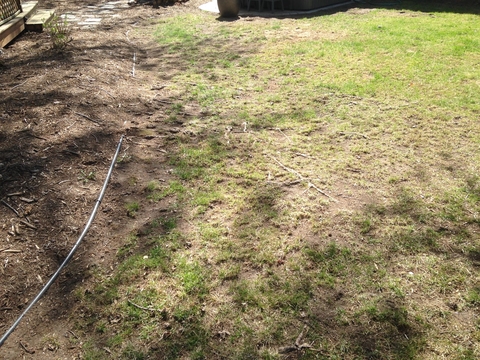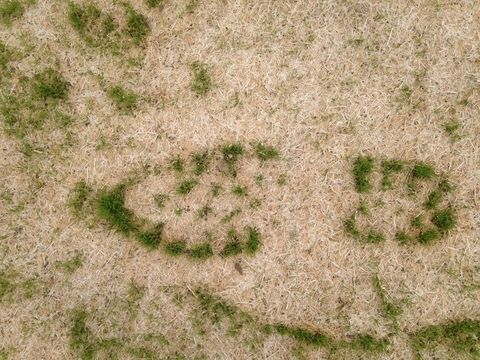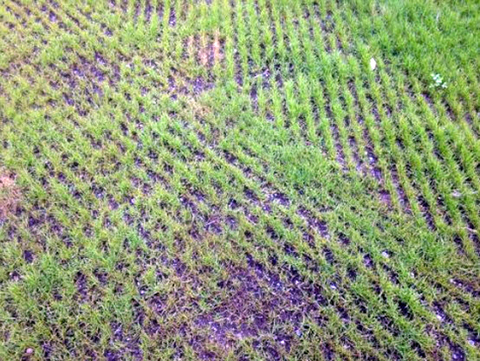You may think that, by November, you should be done with lawn care chores. But you can still help repair or thicken the lawn for next year with dormant seeding.
Seed will remain dormant if soil conditions are cold enough, but begin to germinate as soon as the soil starts to warm in the spring. So you don't have to prepare the soil when it is still wet and cold in the spring, which can result in a head start of several weeks getting the lawn established.
This method generally works best when the newly seeded areas are covered with several inches of snow soon after seeding that remains in place over the entire winter. Winters with extended warm periods followed by extremely cold periods can negatively affect spring germination of dormant seeded lawns.
Dormant seeding works best when you want to reseed bare soil areas or help thicken up thin lawns. It is not as effective where lawns are thick and dense because good seed-to-soil contact is necessary for the grass seeds to germinate and grow next spring.
When to dormant seed
The time to dormant seed is important. If done too early, some seed will germinate late in the season and those immature seedlings often won’t survive the winter. Put down your seed while the ground is not frozen, but is still cold enough so germination of the grass seed will not occur until next spring. Usually, this is from late October to mid-November depending on your location.
This is also the best time of year to start a bee lawn. Early November to mid-December is usually the best time, but it will vary each year depending on weather conditions. You must be quite sure that the seed will not germinate in the current year and it stays inert until the following spring.
Other than the time of year for dormant seeding, preparing the area to be seeded is virtually identical to establishing grass from seed at other times of the year.
Choose well-adapted seed
When choosing the seed to use, be sure to select seed mixes that are well-adapted to both your site conditions and the amount of maintenance you expect to provide during the growing season.
For average lawn conditions, mixes containing some Kentucky bluegrass, fine fescue and small amounts of perennial ryegrass can be sown at about three to four pounds per 1,000 square feet. Any grass seed mixture can be used for dormant seeding.
Establish good seed-to-soil contact
Mow the existing lawn slightly lower than normal, down to about 2 inches. This will allow seed applied over the top to reach the soil. Loosen the soil surface so the seed can easily be incorporated into the surface quarter-inch or so of loose soil.
- Use a hand rake to prepare small areas of bare soil or a thin turfgrass stand.
- Larger areas of sparse turfgrass can be prepared by lightly going over the surface with a power rake or vertical mower.
- Set the blades just deep enough to penetrate into the top 1/4 inch or so of soil.
- This will also help remove small thatch layers that may be present, as well as any dead grass plant parts lying on the surface of the soil.
- Rake up the grass plant debris that was brought to the surface from this process so that it will not interfere with sowing the grass seed. This debris can easily be composted or used as mulch in another area of the landscape.
Once the soil is loosened, spread grass seed at the recommended rate and lightly incorporate it into the existing soil with a hand rake.
You also could use a slit seeder, a machine that creates a shallow slit in the soil into which the seed is dropped, lightly covered and packed down. You may be able to rent one. This practice usually is done by a lawn care professional.
Water thoroughly, but not too much
Water the area thoroughly and leave it until next spring. Apply from 0.05 to 0.10 inches of water. At this time of year, cool temperatures and short days will help keep the areas moist far longer than in summer. While just barely damp soil is okay, it is important that the area does not become soggy and saturated with water.
If the weather does turn a little warmer and drier and the area starts to dry out, you may need to lightly water the area just to keep it damp and prevent it from becoming too dry.
What to expect for next spring
The success of your dormant seeding will depend on the winter conditions. The seed is best protected when we receive snowfall that will cover and protect those areas.
You should be able to see germinated seedlings by late April or early May in most years. You can assess at this time if you need more overseeding.
If the newly seeded areas appear to be a little thin, don't think your fall efforts were a failure, as it is common to have to do a little additional reseeding in the spring. But do allow enough time for the seeds to come up. Don't be too hasty to get in and start tearing things up; you just may be destroying all of the good work done the previous fall.
If you are certain the dormant seeding did not succeed, the area can always be overseeded the following spring. The light disturbance of the dormant seeded area during an overseeding process should not be a significant problem for the seedlings that have germinated.
Don't tear out or destroy the young seedlings that are germinating with excessive traffic on the dormant seeded area. Consider fertilizing these areas in May to encourage establishment.
Reviewed in 2024





